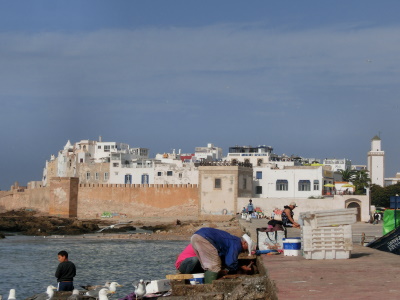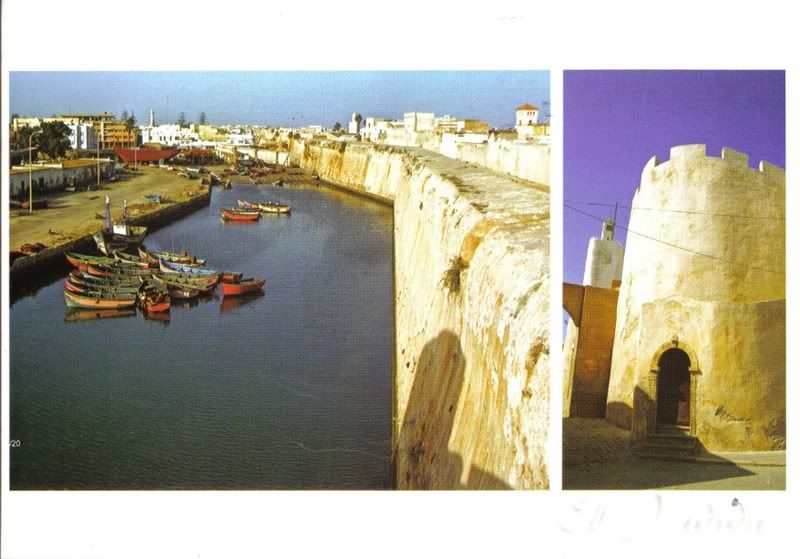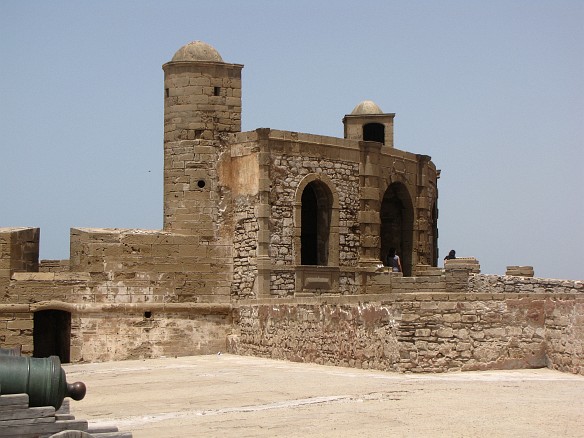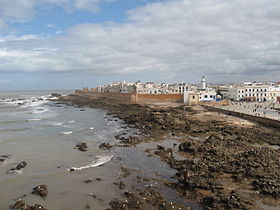Medina of Essaouira (formerly Mogador)







Essaouira is an exceptional example of a fortified town of the late eighteenth century, built in North Africa according to the principles of European military architecture of the time. Since its founding, it has remained an international trading port of the first, linking Morocco and its Saharan hinterland with Europe and the world.
Brief summary
The Medina of Essaouira, formerly known as Mogador (name from the Phoenician word Migdol, meaning "fortress"), is an outstanding example of a fortified city from the mid-eighteenth century, surrounded by a wall of Vauban style. Built in North Africa according to the principles of European military architecture of the time, in perfect combination with the precepts of architecture and urbanism Arab-Muslim, she played for centuries, the role of harbor of major international trading, linking Morocco and sub-Saharan Africa to Europe and the world. The city also offers an example of a multicultural center as shown in coexistence, from his conception of various ethnic groups such as the Amazigh, Arabs, Africans and Europeans and multi-faith (Muslims, Christians and Jews). Inseparable from the medina, the islands of Mogador has a large number of cultural and natural sites of outstanding universal value. Its founding relatively late compared to other medinas of North Africa was the work of Sultan Sidi Mohamed Ben Abdallah Alawi (1757-1790) who wanted to make this small town Atlantic port and a royal capital of the Moroccan trade with the outside. Long known as the Port of Tombouctou, Essaouira became one of the cornerstones of the Atlantic slave trade between Africa and Europe in the late eighteenth century and throughout the nineteenth century.
Criterion (ii): Essaouira is an outstanding example, well-preserved walled port city of mid-eighteenth century European high inspiration, transposed into a North African context.
Criterion (iv): With the opening of Morocco on the world in the late seventeenth century, the Medina of Essaouira was designed by a French architect deeply influenced by the work of the military engineer Vauban at Saint-Malo . It has largely retained the appearance of a European city.
Integrity (2009)
Completed in the nineteenth century and clearly defined by its walls, the Medina of Essaouira has all the elements essential to its integrity. Forming a homogeneous combination of natural assets (islands of Mogador) and cultural goods of high quality, the city still retains its integrity and original character. Although its integrity has been somewhat altered, in particular due to the degradation of buildings in the Mellah, the degree of loss does not compromise the significance of the property as a whole.
The conservation status of the Medina of Essaouira continues to improve through the efforts of local authorities and vigilance services directly involved in its protection and enhancement.
Authenticity (2009)
Founded in the mid-eighteenth century, the Medina of Essaouira has largely retained its authenticity in terms of both design and forms at the level of materials (use of local stone called manjour) and construction methods and that despite some inappropriate uses of modern materials for repairs and reconstructions. Despite the wave action on the sea side and humidity elsewhere, the urban fortifications and maintain, in all their original configuration.
Needs protection and management (2009)
Protection measures are essentially different laws listing of historic monuments and sites, particularly the law relating to 22-80 Moroccan heritage. Property of the elements constituting the historic town of Essaouira is divided between the State, municipality, Endowments, the Alliance Israelite, cooperatives and individuals. The Master Plan No. 4001 of 1988 provides around the historic city a buffer zone where construction is prohibited. Two measures of protection and management are significant inputs in the final stages of application. This is the blueprint for urban development in the city of Essaouira and the backup plan of the medina.
Local people, governments and the associative space are increasingly sensitive to the outstanding universal value of the medina. The Urban Agency of Essaouira was created to ensure better control of the urbanization of the city in general and in particular the medina. This should allow, in parallel with other ministerial departments, to plan and coordinate efforts and monitor the progress and implementation of projects initiated or planned. Pending the establishment of a management plan of the medina which is expected to reconcile the conservation of architectural heritage and the improvement of living conditions of local people, the services involved in the protection and preservation of the property must ensure the implementation of the development plan of the medina and the entire city of Essaouira.
Long Description
[English only]
Essaouira year is outstanding and well-preserved example of a late 18th-century European fortified seaport town translated to a North African context. With the opening up of Morocco to the rest of the world in the later 17th century, the town WAS ugly out by a French architect Who Influenced profoundly HAD beens by the work of Vauban at Saint-Malo. It Has Retained icts European appearance to a substantial businesses extent.
Icts since foundation in the 18th century and Until the Beginning of the 20th century, Essaouira HAS Fundamental Role Played a year as international trading harbor Between Morocco and the rest of the world. A number of consular and traders from different Countries Were Established there. Essaouira is a leading example of building inspired by European architecture, a town only by Virtue of ict design: it was created in conformité with a predetermined plan, the plan Cornut. Since The Beginning, the medina of Essaouira has-been a major place for the peaceable coming together of the architectural and town-planning models of Europe and of Morocco for itself. In this way a symbiosis WAS Achieved Between technical building from Morocco and Elsewhere That Gave birth to unique architectural masterpieces Some: the Sqalas of the harbor and of the medina, the Bab Marrakech bastion, the Water Gate, mosques, synagogues, churches, etc..
Archaeological excavations Have Shown That the site of Essaouira WAS Originally a Phoenician trading settlement, Followed by Cretans, Greeks and Romans. Earlier the name of Mogador derived from Migdol, meaning-a small box. In 1506 It Was to Become the site of a Portuguese fortress, this goal WAS abandoned soon after.
The present town dates from 1765, When the Alawite Sultan Sidi Mohamed Ben Abdellah Decided to build a harbor That Would open Morocco up to the outside world and assist in Developing trade relationships with Europe. He Sought the help of Nicholas Theodore Cornut, a specialist in military fortifications surveyor from Avignon, Influenced by Who Was Strongly Vauban's Defences at Saint-Malo. He Partially dismantled the Portuguese fortress to build year esplanade with a row of cannons. The Entire town WAS enclosed by a defensive wall on the Vauban model. In order to control maritime trade, the southern coast ET closed to European traders, obliging the European consuls at Safi, Agadir and Rabat to move to Mogador, where 'all southern mercantile activities Were concentrated. The new port Became one of the country's main shopping centers; It Was Called the 'port of Timbuktu' As It Was the destination of caravans Bringing a Variety of products (Including Slavic) from black Africa. The Town Was Made up of Three Separate districts. The old kasbah comprised the administrative district. The medina WAS crossed by Two hand axial streets, one running from Bab Doukalla to the harbor and the Other from Bab Marrakesh to the sea. There Were At Their intersection oven Markets, for fish, spices, grain and general goods respectively.
The Mellah is the Jewish quarter; it Played a very significant role in the history of the town, as the Sultan made use of this community to ESTABLISH relationships with Europe and to organizes business activities with 'em. The main features of the town are: the ramparts, most is of the northern section of Which Survives; the town gates, ornamental Especially the Sea Gate (1170-1171), the bastions and forts (borjs), Especially the Sqala of the Port and the Sqala of the Medina and the Bastion of Bab Marrakesh, the kasbah, Which was Originally the seat of power and the military garrison, and is now integrated Into the town proper, the Mellah (Jewish quarter), Which Retains Many Of icts original special features; the prison, Located on the offshore island (now a haven for unusual birds, Such as hawks); The Many mosques, in a characteristic style, and Especially the mosques of the Casbah and Ben Yosef, the synagogues (In Particular the 19th -century synagogue of Simon Attias) Which preserve the dynamism of the Jewish Inhabitants; the late 18th-century Portuguese church, the Dar-Sultan (old Royal Palace) and the very attractive private houses.
Source: UNESCO / CLT / WHC
Historical description





Archaeological excavations have revealed that the site of Essaouira was originally a Phoenician. Then came the Cretans, Greeks and Romans. Mogador, its old name, comes from the Phoenician word Migdol, meaning "fortress". In 1506 the city had become the seat of a Portuguese fortress but was abandoned shortly after.
The present city dates from 1765, years during which the Alawite Sultan Sidi Mohamed ben Abdallah decided to build a port in Morocco intended to provide an opening to the outside world while allowing the development of trade relations with Europe. He then requested the assistance of Theodore Cornut, engineer of military fortifications of Avignon who was strongly influenced by the fortifications of Vauban at Saint-Malo. It partially dismantles the Portuguese fortress in order to build the Scala, esplanade with a row of cannons. He organized the city checkerboard, with strong follow those of Roussillon, in the European tradition. The entire city was enclosed by a wall of Vauban style.
During the reign of Sidi Mohamed ben Abdallah, Mogador plays a significant commercial and tax. To control maritime trade, the Sultan farm south coast to European traders, forcing the European consulates in Safi, Agadir and Rabat to settle in Mogador, instead of concentration of all market activities in the south. The new port became one of the major ports and, to be the destination for caravans bringing African black a variety of loads (including slaves), it is called "port of Timbuktu".
The city is divided into three neighborhoods. Kasbah includes the old administrative district. Medina is built between the eighteenth century and early twentieth century. It is crossed by two main lines, one connecting Bab Doukkala port and the other starting from Bab Marrakech to reach the sea at their intersection, or Souk Jdid, are then installed four markets respectively devoted to fish, spices, grain and groceries. Each district is named after the tribes involved in building the city.
The Mellah Jewish quarter, played an important role in the history of the city because the Sultan used the Jewish community to build relationships with Europe and organize business activities. Jews were honored as Toujjar Es-Sultan (Merchant Royal), which conferred upon them of considerable economic and political privileges.